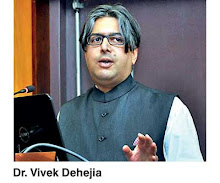The challenge of formalizing the Indian economy
Vivek Dehejia
Published: Mint, July 2, 2018, p. 14.
It is widely agreed that India stands at the cusp of three vital transitions, if it is to transform itself from an emerging to a development market economy. These are: rural to urban; farm to factory; and informal to formal. (To my knowledge, it is Manish Sabharwal who in recent years has popularised this formulation, although the concept long predates its present usage.)
There are few dissenters to this consensus, although it must be said that there have always been those who have harboured the pipe dream (for that is what it is) that India can leapfrog from agriculture to high-technology services, bypassing manufacturing altogether. That canard has been taken up in these pages earlier, and a further debunking is in the offing in a future column, given that some bad ideas simply refuse to go away.
However, today, let us interrogate further the last of the triptych, which is the transition from a largely informal to a largely formal economy. As this writer has argued on numerous occasions, it was widely hoped that the twin policy shocks of demonetization and the goods and service tax (GST), the second hot on the heels of the first, would help to jumpstart this transformation.
As regular readers will be aware, the last instalment of this column, co-written with Rupa Subramanya, tested the notion that demonetization succeeded in making India into a less-cash society — in other words, pushed digitization — which is one facet of the goal of formalization. As we saw, despite the best of intentions, and of hopes for success, the goal of less-cash has not been realized.
What about the other dimensions of formalization? These may be conceptualised broadly as the process of bringing more business firms and households under the tax and regulatory nets — whether of corporate tax, personal income tax, GST, provident fund contributions, labour laws, environmental regulations, and so forth. Evidently, both demonetization and the creation of GST should push in this direction, as it becomes more difficult for firms and people to remain in the black or grey economies, which operate almost entirely on a cash basis and which fly below the radar screen of taxation and regulation.
The crux, as I argued in a small group meeting with Prime Minister Narendra convened by NITI Aayog in December 2016, must be to supplement sticks with carrots. Demonetization and GST are clearly sticks, but what would be needed would be carrots in the form of a reduced tax and regulatory burden — in short, an improved ease of doing business and, more broadly, a reduced role for the state in the economy — which would entice businesses and households into the formal economy, rather than yank them into it under duress.
While some important progress has been made — the Insolvency and Bankruptcy Code (IBC) being the most notable — it must be said that the overall tax and regulatory burdens remain higher than they ought to be, and higher than they need to be if there are going to be sufficient carrots and not just sticks to goad formalization. Anecdotal evidence suggests that compliance with GST is onerous, in addition to the direct costs it imposes on businesses. The drive for digitisation and less-cash, in turn, has been hindered, one can conjecture, by spotty high speed internet coverage and a shaky technological architecture behind the scenes, leading to frustrations such as failed transactions and delayed refunds. This is to say nothing of legitimate security and privacy concerns associated with going formal and going digital.
Having said that, it remains true that the three transitions with which we began, and, in particular focus in today’s column, the transformation from formal to informal, are absolutely indispensable elements of economic development. There is simply not a single developed market economy which has a high level of informality: it follows, therefore, that formalisation is a necessary, although not a sufficient, condition for economic modernization. It should be added that the direction of causality is not necessarily unidirectional from formalisation to a higher level of per capita income, and virtuous feedback loops almost certainly exist. As a corollary, given the positive feedbacks, multiple equilibria are possible, such that there may be a low-level trap in which both formalisation and per capita income are low.
With the next general election now less than a year away, this is not, realistically, the juncture at which to propose major new economic reforms. Rather, whichever government comes to power after the elections, of whatever stripe and configuration it may be, will need to revisit the conundrum of how to push along greater formalization, and this will most certainly entail the need for reducing the tax and regulatory burdens on people and businesses — in other words, “supply side” reforms. Privatisation of public sector units, which has largely gone begging under the present government — witness the failed recent attempt to sell Air India — must come back to centre stage.
The government is still too prominent at the “commanding heights” of the economy, and it must recede further, making room for a rejuvenated private sector. That, in turn, will require that the “twin balance sheet” problem — of bad bank and corporate debt — be resoled sooner rather than later. The IPC will be of help here, but we must not fall into the trap of thinking of it as a silver bullet that eliminates the need for further structural reforms.
Vivek Dehejia is a Mint columnist and resident senior fellow at IDFC Institute, Mumbai.
